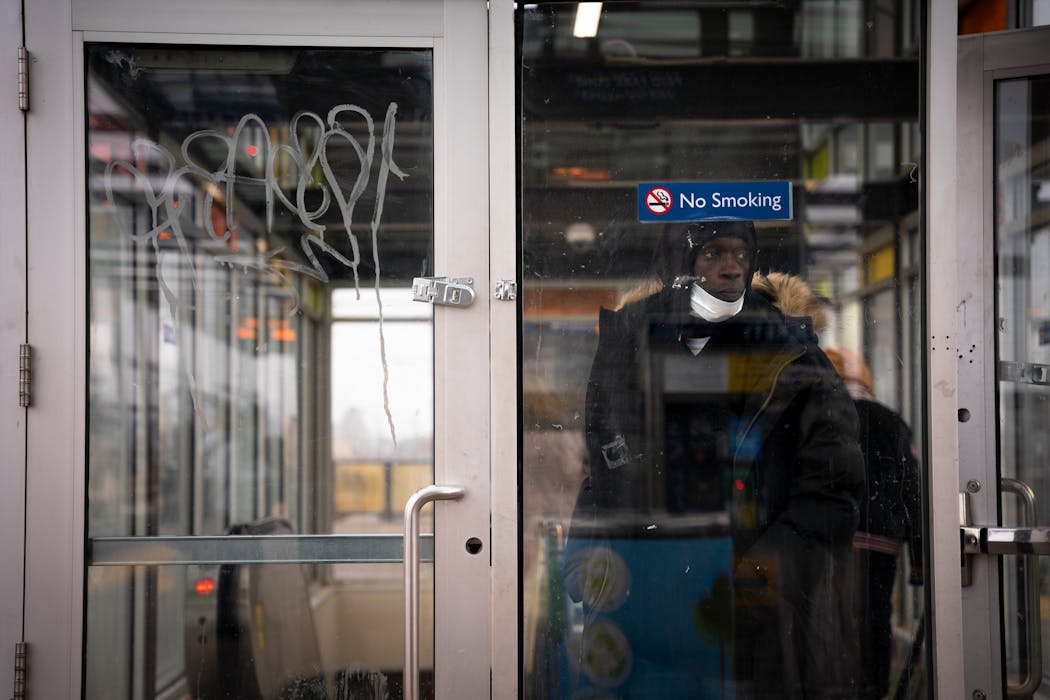
The Lake Street/Midtown light-rail station in south Minneapolis is one of the Blue Line's busiest stops — and one of the most frequently vandalized and policed among Metro Transit's stations.
The transit agency recently awarded a contract to a St. Paul firm for up to $3.5 million to craft a renovation plan for the nearly 20-year-old elevated station at the intersection of Lake Street and Hiawatha Avenue. Construction is expected to begin as early as 2025.
The station's appearance is dire: elevators and escalators are frequently out of service, glass enclosures often shattered, and the overall ambience is downright grubby.
Worse yet are recurring reports of criminal activity at the station, including a highly publicized shooting last year witnessed by a Minneapolis City Council member who took to social medial to decry conditions there.
Plans to refresh the station, which have been in the works for a few years, will dovetail with nearby road work and track improvements on the Blue Line, which connects the Mall of America with Target Field in downtown Minneapolis.
Metro Transit officials say the general purpose of the project is to provide more reliable, safe and consistent access between the elevated platform and the street, as well as improve cleanliness, signage, comfort, visibility, lighting and safety. More durable and energy-efficient materials will be used, and the canopy protecting passengers from the elements will be expanded.
A final design and budget for the renovation hasn't been crafted yet. The Metropolitan Council, which operates Metro Transit, approved a contract in December with St. Paul-based 4RM+ULA to lead the project. The minority-owned firm has previously worked on Green Line light-rail stations.
"As a regular user of this station, I know how important it is to both our riders and the wider community," said Metro Transit General Manager Lesley Kandaras. "I'm glad the design work is getting underway and look forward to welcoming riders back to a new and improved station when construction is complete a few years from now."
The overhaul comes as Metro Transit seeks to regain significant ridership lost during the COVID-19 outbreak, and to woo back wary passengers worried about criminal and nuisance behavior on trains.
Transit officials say that boardings at the Lake Street/Midtown Station — the latest weekday average is about 1,800 — have recovered to pre-pandemic levels, reinforcing that the location is an important cog in the regional transit system.
The station has two enclosed towers on either side of Lake Street, each with an elevator, escalator and stairway. In recent years, the elevators and escalators have frequently been out of service. Plans call for the escalators to be removed and a pedestrian ramp added on the south side of Lake Street, along with new and larger elevators that will be closer to Lake Street's bus stops.
The new design will minimize the use of glass, which "collects dirt and debris," said Christina Morrison, a Metro Transit project manager, at a recent Met Council meeting.
Planned improvements also include space containing a sink and power source for employees who clean the station, as well as staff-only restrooms for police and private security guards.
"We have police and security out there so we want to provide better spaces for them," Morrison said, allowing them "to do the job better and actually stay on the premises" longer.
The private guards are part of a broader effort launched in 2023 to boost security in the transit system. Since then, Metro Transit spokesman Drew Kerr said there has been "an encouraging drop in calls for service and reported crimes at [the Lake Street] station, which can be attributed to increased police and security officer presence."
The station is at a key street-level connection with Route 21 bus service along Lake Street in Minneapolis and Marshall and Selby avenues in St. Paul. Come 2025, the new B Line arterial bus-rapid transit line will begin service along the route.
Those living in the neighborhoods served by the Lake Street/Midtown Station are frequent transit users. About 60% of area households have access to only one car, if that, and people with disabilities make up 13% of the population, according to Metro Transit.
"It's definitely something where there's the opportunity to improve accessibility and the customer experience," said Deb Barber, chair of the Met Council's Transportation Committee, last November.
New Minnesota GOP leaders seek peace with party's anti-establishment wing

Who is Republican Lisa Demuth, Minnesota's first House speaker of color?

Minnesota House GOP, Secretary of State Steve Simon return to Supreme Court
Supreme Court sides with DFL and Simon, says 68 House members needed for floor action




